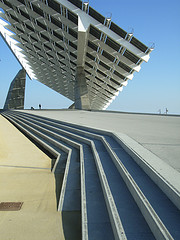
The Middle East has long been known as the petrol capital of the world, but it soon could become better known for its renewable energy assets. New environmental efforts throughout the Sun Belt may transform the rainless region into the world’s largest harvester of renewable energy, in addition to creating the greenest city on the planet. The end of oil doesn’t necessarily mean the end of our dependence on foreign resources.
Countries in the Middle East and North Africa, including mainly Saudi Arabia, Jordan, Egypt, and Algeria, have been approached by twelve European countries looking to buy cheap solar power. Forbes reporter William Pentland reports that because the Sun Belt countries are endowed with a great deal of sunlight, they can potentially harvest and send cheap solar power to Europe through underwater cables. Talks of whether to undergo the 400-billion-euro ($560-billion) plant construction proposal, called the Desertec Industrial Initiative, have concluded. Now, details must be worked out to determine where to build the plants, costs, profits, political stability agreements, and funding. According to the Agence France-Presse (AFP), Sun Belt solar farms are estimated to supply 15 percent of Europe’s energy by 2050; they also have the potential to produce four times the world’s energy consumption, keeping the Middle East in control of cheap energy.
Greenest City On The Planet
The Middle East’s United Arab Emirates has its own plan of going green. Construction has started on Masdar City, to be the greenest city in the world. The 2.5 square mile city is located 18 miles east of the capital Abu Dhabi, and will invest in several clean-tech ventures in order to sustain entirely on renewable energy and create nearly zero waste. There will be no cars allowed in the carbon-neutral city, and all transportation will be provided by an underground rail system.
Science Daily reports that Masdar City will utilize a state-of-the-art desalination plant to purify and reuse water, and waste water will be recycled and used to grow biofuel crops. The city will have canopies of solar panels to capture solar power and provide shade. There will be a focus on creating energy efficient buildings, and sustainable development will be practiced and emphasized. The modern Masdar Institute of Science and Technology hopes to attract the world’s leading scientists and researchers. Tall walls around Masdar will block the noise from the Abu Dhabi airport, but will allow sea breezes to cool the city. Masdar City’s carrying capacity will be around 50,000, and although it should be another ten years before construction is complete, residents are expected to begin populating the city this year. If you’re sick and tired of your high gas bills and outrageous pump prices, you should consider a move to the Middle East.

